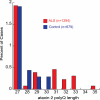Ataxin-2 intermediate-length polyglutamine expansions in European ALS patients
- PMID: 21292779
- PMCID: PMC3071667
- DOI: 10.1093/hmg/ddr045
Ataxin-2 intermediate-length polyglutamine expansions in European ALS patients
Abstract
Amyotrophic lateral sclerosis (ALS) is a fatal adult-onset neurodegenerative disease primarily affecting motor neurons. We recently identified intermediate-length polyglutamine (polyQ) expansions (27-33 Qs) in ataxin 2 as a genetic risk factor for sporadic ALS in North American ALS patients. To extend these findings, we assessed the ataxin 2 polyQ repeat length in 1294 European ALS patients and 679 matched healthy controls. We observed a significant association between polyQ expansions and ALS (>30 Qs; P= 6.2 × 10(-3)). Thus, intermediate-length ataxin 2 polyQ repeat expansions are associated with increased risk for ALS also in the European cohort. The specific polyQ length cutoff, however, appears to vary between different populations, with longer repeat lengths showing a clear association. Our findings support the hypothesis that ataxin 2 plays an important role in predisposing to ALS and that polyQ expansions in ataxin 2 are a significant risk factor for the disease.
Figures
Similar articles
-
Distinct TDP-43 pathology in ALS patients with ataxin 2 intermediate-length polyQ expansions.Acta Neuropathol. 2012 Aug;124(2):221-30. doi: 10.1007/s00401-012-0985-5. Epub 2012 Apr 21. Acta Neuropathol. 2012. PMID: 22526021 Free PMC article.
-
ALS-associated ataxin 2 polyQ expansions enhance stress-induced caspase 3 activation and increase TDP-43 pathological modifications.J Neurosci. 2012 Jul 4;32(27):9133-42. doi: 10.1523/JNEUROSCI.0996-12.2012. J Neurosci. 2012. PMID: 22764223 Free PMC article.
-
Ataxin-1 and ataxin-2 intermediate-length PolyQ expansions in amyotrophic lateral sclerosis.Neurology. 2012 Dec 11;79(24):2315-20. doi: 10.1212/WNL.0b013e318278b618. Epub 2012 Nov 28. Neurology. 2012. PMID: 23197749
-
Model organisms reveal insight into human neurodegenerative disease: ataxin-2 intermediate-length polyglutamine expansions are a risk factor for ALS.J Mol Neurosci. 2011 Nov;45(3):676-83. doi: 10.1007/s12031-011-9548-9. Epub 2011 Jun 10. J Mol Neurosci. 2011. PMID: 21660502 Free PMC article. Review.
-
Taking a risk: a therapeutic focus on ataxin-2 in amyotrophic lateral sclerosis?Trends Mol Med. 2014 Jan;20(1):25-35. doi: 10.1016/j.molmed.2013.09.001. Epub 2013 Oct 16. Trends Mol Med. 2014. PMID: 24140266 Review.
Cited by
-
Sequence composition changes in short tandem repeats: heterogeneity, detection, mechanisms and clinical implications.Nat Rev Genet. 2024 Jul;25(7):476-499. doi: 10.1038/s41576-024-00696-z. Epub 2024 Mar 11. Nat Rev Genet. 2024. PMID: 38467784 Review.
-
NeuroGeM, a knowledgebase of genetic modifiers in neurodegenerative diseases.BMC Med Genomics. 2013 Nov 14;6:52. doi: 10.1186/1755-8794-6-52. BMC Med Genomics. 2013. PMID: 24229347 Free PMC article.
-
Association of ATXN2 intermediate-length CAG repeats with amyotrophic lateral sclerosis correlates with the distributions of normal CAG repeat alleles among individual ethnic populations.Neurogenetics. 2019 May;20(2):65-71. doi: 10.1007/s10048-019-00570-9. Epub 2019 Mar 7. Neurogenetics. 2019. PMID: 30847648
-
Intermediate Repeat Expansion in the ATXN2 Gene as a Risk Factor in the ALS and FTD Spanish Population.Biomedicines. 2024 Feb 2;12(2):356. doi: 10.3390/biomedicines12020356. Biomedicines. 2024. PMID: 38397958 Free PMC article.
-
The changing scene of amyotrophic lateral sclerosis.Nat Rev Neurosci. 2013 Apr;14(4):248-64. doi: 10.1038/nrn3430. Epub 2013 Mar 6. Nat Rev Neurosci. 2013. PMID: 23463272 Review.
References
-
- Rosen D., Siddique T., Patterson D., Figlewicz D., Sapp P., Hentati A., Donaldson D., Goto J., O'Regan J., Deng H., et al. Mutations in Cu/Zn superoxide dismutase gene are associated with familial amyotrophic lateral sclerosis. Nature. 1993;362:59–62. doi:10.1038/362059a0. - DOI - PubMed
-
- Eisen A., Mezei M.M., Stewart H.G., Fabros M., Gibson G., Andersen P.M. SOD1 gene mutations in ALS patients from British Columbia, Canada: clinical features, neurophysiology and ethical issues in management. Amyotroph. Lateral. Scler. 2008;9:108–119. doi:10.1080/17482960801900073. - DOI - PubMed
-
- Neumann M., Sampathu D.M., Kwong L.K., Truax A.C., Micsenyi M.C., Chou T.T., Bruce J., Schuck T., Grossman M., Clark C.M., et al. Ubiquitinated TDP-43 in frontotemporal lobar degeneration and amyotrophic lateral sclerosis. Science. 2006;314:130–133. doi:10.1126/science.1134108. - DOI - PubMed
-
- Pesiridis G.S., Lee V.M., Trojanowski J.Q. Mutations in TDP-43 link glycine-rich domain functions to amyotrophic lateral sclerosis. Hum. Mol. Genet. 2009;18:R156–162. doi:10.1093/hmg/ddp303. - DOI - PMC - PubMed
-
- Kwiatkowski T.J., Jr, Bosco D.A., Leclerc A.L., Tamrazian E., Vanderburg C.R., Russ C., Davis A., Gilchrist J., Kasarskis E.J., Munsat T., et al. Mutations in the FUS/TLS gene on chromosome 16 cause familial amyotrophic lateral sclerosis. Science. 2009;323:1205–1208. doi:10.1126/science.1166066. - DOI - PubMed
Publication types
MeSH terms
Substances
Grants and funding
LinkOut - more resources
Full Text Sources
Other Literature Sources
Medical
Miscellaneous


